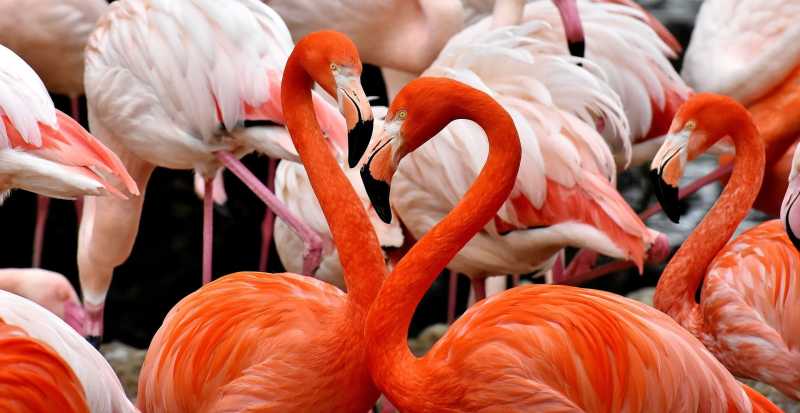What Makes Flamingoes Pink – Flamingos are one of the most famous creatures in the animal kingdom, easily recognized by their bright pink feathers. However, when flamingos were first brought into zoos from the wild, keepers were horrified to find that they had lost their bright pink color and turned grey/white.
It turns out that the secret to flamingos’ pink feathers comes from their diet. In the wild, flamingos eat algae and invertebrates that contain things called carotenoids. Carotenoids contain pigments that dissolve in the flamingo’s fat and are then deposited in the flamingo’s growing feathers, giving them their color. If this is removed from the flamingo’s diet, the color will be lost and the feathers will turn a natural gray.
What Makes Flamingoes Pink

Flamingos vary in color depending on the amount of pigment in their diet, they can range from pale pink to crimson. In captivity, flamingos are fed pellets containing the pigment found in their natural diet in the wild to maintain their pink color. Carotenoids can be found in many common fruits and vegetables such as tomatoes, oranges and carrots, which gives them their distinctive colors.
The Natural Habitat Of The Plastic Pink Flamingo
Unfortunately, humans do not turn red from the same diet as flamingos, humans lack the metabolic mechanism used to convert it into pigment and deposit it in hair.
However, there have been cases of people’s skin turning strange colors after consuming carotenoids, for example in 1999 a child turned yellow after drinking too much Sunny Delight! The same thing can happen with excessive consumption of carrots, sweet potatoes or zucchini, a condition called carotenemia.
A Greenland shark is so slow that it can only eat something if it is asleep, dead, or wanders into its mouth There is a species of jellyfish that is biologically immortal There is a species of ant that has a neck instead of a head What is Schmidt Sting Pain Index? Known for their long legs and striking bright pink plumage, flamingos are wading birds that live in the Americas, Asia, Africa and parts of southern Europe, although they have been known to flourish as far north as Germany.
The name flamingo comes from the Portuguese/Spanish word “flamengo” which translates to “color of flame” in reference to their vibrant plumage, however, they are not actually born pink. Instead, when flamingo chicks hatch, their feathers have a dull gray color.
Pinker Flamingos Are More Aggressive, Intriguing Study Finds
The reason flamingos are pink lies in their diet of algae, shrimp and crabs. The marshy habitats they call home are full of blue-green algae, which despite their name are actually red or orange in color due to a chemical known as beta carotene. This chemical has a red-orange pigment in it known as a carotenoid, which is also found in carrots, sweet potatoes and spinach.
After the flamingo is eaten, enzymes in the flamingo’s digestive system break down the beta carotene, and the red-orange pigments are absorbed by the fat in its liver. These fats are then deposited in the flamingo’s feathers and skin as it grows. As their diet consists almost exclusively of sources rich in beta carotene, flamingos gradually turn pink.
Flamingo color can vary because carotenoid levels in algae and crustaceans also vary around the world. The species of flamingos found in the Caribbean are often bright red or orange, while those in drier areas are usually a paler pink. Without a high enough concentration of food rich in beta carotene, the pink feathers would molt and new, paler feathers would begin to grow.

Although the sight of colorful flamingos is familiar, there are a number of ways in which they can lose their distinctive hue. The carotenoids themselves can turn white in the sun, something like a sunburn
As The Lakes That Flamingos Inhabit Expand, The Birds’ Food Supplies Are Rapidly Shrinking
It fights by grooming itself directly with pigments secreted from their glands, giving their feathers a brilliant pink sheen.
Flamingos are also one of the few birds that feed their young on crop milk. Not to be confused with the milk produced by mammalian species, the crop milk produced by flamingos is a highly nutritious bright pink secretion produced in the throat of an adult and is so densely packed with carotenoids that when the breeding season is over, both male and female parents often appear white, losing the pink color from the feathers.
Despite numerous reports of blue flamingos appearing online, there is no evidence to suggest that they are anything more than internet scams. However, a number of rare black flamingos have been seen in Cyprus. He is thought to be suffering from a pigment condition called “melanism”, which causes an overproduction of melanin that makes him black.
Life The inside story of heroic efforts to save three species of birds Culture For subscribers only Environment Photos of paradise island reveal plastic threat to bird population Regulars Free life Ancient geese were 3 meters tall and weighed as much as a cow News Free As you know, flamingos are beautiful birds that often we see pink ones. However, the color of their feathers is not hereditary, so there is no gene in their DNA that would pigment them. So why are they pink?
Why Are Flamingos Pink? The Tale Of Food, Feathers, And…
In fact, all flamingos are born gray and later in life turn pink, white or even orange due to their specific diet. Flamingos usually live around water, so they mainly feed on shrimp, algae and crustaceans, all of which can have a pink/orange pigment called carotenoid. When consumed, enzymes in the flamingo’s digestive system break down the carotenoids into orange and pink pigment molecules. In the liver, these molecules are absorbed by fats and then accumulate throughout the flamingo’s body, such as skin, legs, feathers, and even beaks.
However, flamingos are not always rosy. Some may have lighter or darker shades of pink, be slightly orange or even slightly red. They can vary in color depending on their location and the food they consume. For example, Andean flamingos are mostly white because their diet does not contain much carotenoid pigment due to their location in the Andes Mountains of South America.
Flamingos can also change color before breeding season. During this time, they have to act as brightly as possible to attract partners because the pinker the flamingos are, the healthier they are. So those that are pinker have a better chance of mating and producing healthy offspring! However, after that both females and males can lose their pigments. This happens because most of the food is used during the breeding season and is later given to their chicks. Ask Chatbot Games & Quizzes History & Society Science & Technology Biographies Animals & Nature Geography & Travel Art & Culture Money Videos
Although every effort has been made to follow the rules of citation style, there may be some deviations. Please refer to the appropriate style manual or other sources if you have questions.
Featured Creature: Flamingo
Encyclopedia Editors Encyclopedia editors oversee subject areas in which they possess extensive knowledge, either from years of experience working on that content or through advanced degree studies. They write new content and review and edit content received from contributors.
Flamingos are long-legged wading birds that are usually covered in bright pink feathers. With a name derived from a Spanish or Portuguese word meaning “the color of flame,” the birds are known for their colorful appearance. The pink color of their feathers, although it is their most famous quality, is not a hereditary trait. Flamingos are actually born dark gray. So if it’s not part of their DNA, why do these birds turn shades of pink?
For flamingos, the phrase “You are what you eat” holds more truth than it might for humans. Flamingos’ bright pink color comes from beta-carotene, a red-orange pigment found in large amounts in the algae, brine fly larvae, and shrimp that flamingos eat in their wetland environment. In the digestive system, enzymes break down carotenoids into pigments that are absorbed by fats in the liver and deposited, in flamingos, in feathers and skin. In order to actually color these external attributes, carotenoids must be ingested in very large quantities. Since the flamingo’s diet is almost exclusively treats full of carotenoids, the birds have no problem with coloring. Humans, on the other hand, would need to eat quite a lot of carrots (a food so rich in carotenoids that it gives the pigments their name) to keep their skin orange.
There are six different species of flamingos, found in various places around the world. Because habitat and food sources vary from place to place and from season to season, bird colors also vary. Some flamingos are darker or lighter shades of pink, others are more orange or red, and still others are pure white. Flamingo: an exotic bird perhaps best known for its distinctly pink color. Because of this unique technocolor feature, flamingos are a crowd-pleaser in zoos, aquariums, etc. Although it’s true that flamingos are almost synonymous with the color pink, have you ever wondered why flamingos are pink? Especially when so many other animals aren’t? After all, being pink is what makes flamingos so special: so why are they pink inside
Are Flamingos At Seaworld San Diego?
What food coloring makes pink, what makes rose gold pink, what makes lemonade pink, what makes pink eye contagious, what makes rose wine pink, what makes salt pink, what makes bermuda sand pink, what makes pink eye feel better, what makes flamingos pink, what makes hydrangeas pink, what makes lips pink, what makes a diamond pink






